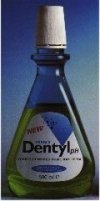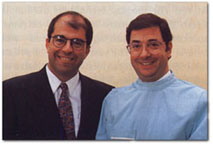
Search my Site:
Get our Bad Breath Research Newsletter!


From: Oil Pollution to Oral Pollution:
Development of the Two-Phase Mouthwash (1996)
Over the past thirteen years, much of our interest in anti-adhesion therapy has focused on
the potential of two-phase, oil:water mixtures to remove oral bacteria and to combat bad
breath. Initially, it was found that a high proportion of oral bacteria adhere to oil
droplets. In 1982, Nesbitt and coworkers showed that Streptococcus sanguis adheres to
toluene droplets. In the same year,  Weiss et al. reported that most oral microbial isolates retrieved from
extracted teeth adhered to hexadecane. In 1983, Rosenberg and coworkers subsequently.
demonstrated that washed, dispersed suspensions of microorganisms obtained directly from
supragingival dental plaque adhered in high proportions to droplets of liquid hydrocarbon.
These initial observations led to the notion of using two-phase oil:water mouthwashes for
physical desorption of oral microbiota. Indeed, other studies have demonstrated that a
wide variety of laboratory strains of oral microorganisms, including Actinobacillus
actinomycetemcomitans, Actinomyces viscosus and Actinomyces naeslundii, Porphyromonas
gingivalis, Streptococcus salivarius, Streptococcus sanguis,and certain Streptococcus
mutans strains, adhere with high affinity to oil droplets. Initial experiments
showed that microorganisms which adhere to hydrocarbons also bind to other nontoxic oils.
Furthermore, in vitro experiments showed that water:oil combinations could desorb bacteria
from plastic surfaces.
Weiss et al. reported that most oral microbial isolates retrieved from
extracted teeth adhered to hexadecane. In 1983, Rosenberg and coworkers subsequently.
demonstrated that washed, dispersed suspensions of microorganisms obtained directly from
supragingival dental plaque adhered in high proportions to droplets of liquid hydrocarbon.
These initial observations led to the notion of using two-phase oil:water mouthwashes for
physical desorption of oral microbiota. Indeed, other studies have demonstrated that a
wide variety of laboratory strains of oral microorganisms, including Actinobacillus
actinomycetemcomitans, Actinomyces viscosus and Actinomyces naeslundii, Porphyromonas
gingivalis, Streptococcus salivarius, Streptococcus sanguis,and certain Streptococcus
mutans strains, adhere with high affinity to oil droplets. Initial experiments
showed that microorganisms which adhere to hydrocarbons also bind to other nontoxic oils.
Furthermore, in vitro experiments showed that water:oil combinations could desorb bacteria
from plastic surfaces.
Desorption could also be demonstrated in vivo, based on removal of erythrosine-stained
bacteria and debris from the mouth following rinsing with a two phase rinse consisting of
saline and olive oil. Similar combinations were also able to remove bound cells from
polystyrene cuvettes.
Despite these initial desorption experiments, the simple aqueous:oil combinations did not
prove particularly effective in improving oral hygiene over time. Furthermore, the two
immiscible oil and water phases posed technical difficulties. In 1989, Goldberg and
coworkers found that adhesion of microorganisms and oral debris to oil was promoted by low
concentrations of cetylpyridinium chloride (CPC), an amphipathic cationic agent which is
commonly added to mouthwashes. This was surprising, since amphipathic agents were
generally considered to inhibit adhesion at the oil:water interface. Since CPC is an
antibacterial agent, its addition had several additional advantages, including inhibition
of microbial activity in the mouth, and increasing shelf life of the product by preventing
microbial outgrowth. Furthermore, addition of an amphipathic agent such as CPC to
oil:water mixtures results in a temporary emulsion following shaking. This in turn enabled
the mixture to be supplied in a single bottle. Prototype formulations, consisting of
an aqueous phase containing CPC, and an oil phase comprising a mixture of vegetable and
essential oils, were subsequently developed and tested. Such formulations maintained
dramatic in vitro bacterial desorption properties, removing over 90% of a bacterial film
of A. calcoaceticus RAG-1 on polystyrene cuvettes, as compared to 15-50% removal for a
series of commercial mouthwashes.
In an initial clinical study, published by Rosenberg and coworkers in 1992, the prototype
two-phase rinse was compared with (i) a placebo rinse; and (ii) a mouthrinse containing
0.2% chlorhexidine gluconate (Corsodylİ , ICI).
Subjects performed oral rinsing prior to bedtime and in the morning of the following day.
Measurements were taken in the late afternoon (e.g.  at least eight hours following rinsing) of the second day and were
compared to those taken the previous day afternoon prior to rinsing. The data demonstrated
that rinsing with the two-phase mouthwash results in daylong reduction in microbial
levels, as well as in oral malodor. In an independent Japanese study employing the same
two phase formulation, Yaegaki and Sanada showed dramatic reductions in volatile sulphide
levels 3.5 hours after use, as compared to a commercial mouthwash (Skoalİ). These authors
suggested that physical desorption of the particulate oral debris by the mouthrinse was an
important factor in malodor reduction.
at least eight hours following rinsing) of the second day and were
compared to those taken the previous day afternoon prior to rinsing. The data demonstrated
that rinsing with the two-phase mouthwash results in daylong reduction in microbial
levels, as well as in oral malodor. In an independent Japanese study employing the same
two phase formulation, Yaegaki and Sanada showed dramatic reductions in volatile sulphide
levels 3.5 hours after use, as compared to a commercial mouthwash (Skoalİ). These authors
suggested that physical desorption of the particulate oral debris by the mouthrinse was an
important factor in malodor reduction.
In 1992, the prototype two-phase oil-water mouthwash was reformulated and introduced in
the Israeli market by a local company. A clinical study carried out by Kozlovsky and
coworkers was performed to compare the efficacy of the commercial version of the two-phase
mouthwash with Listerineİ, a mouthrinse which has been previously shown to be effective
in reducing levels of odor-related microorganisms, as well as plaque and gingivitis. In
the study, fifty subjects rinsed with one of the two mouthwashes for 30 seconds twice a
day over six weeks, while continuing their regular oral hygiene habits. In both mouthwash
groups, dramatic improvements were observed in parameters associated with oral microbial
levels, malodor, periodontal health and plaque accumulation. For example, as compared to
time zero scores, whole mouth odor, tongue dorsum anterior and posterior odors decreased
continuously over time, attaining 80%, 79% and 70%, reductions, respectively following 6
weeks, in the two-phase mouthwash (Assutaİ) group, vs. 70%, 77% and 59% for the
Listerineİ group. For whole mouth and tongue dorsum posterior, the reductions observed in
the two-phase mouthwash group were significantly greater than those obtained with
Listerineİ (p=0.026 and p=0.025, respectively), suggesting that the two-phase mouthwash
is superior to Listerineİ in long-term reduction of oral malodor.
 In
1996, the rights to introduce the two-phase mouthwash in the United Kingdom were acquired
from Tel Aviv University by a British dentist, Dr. Philip Stemmer, who set up a company
dedicated to this purpose. The United Kingdom version of this product, called Dentyl pH™, is now being
successfully marketed throughout England, Scotland, Wales and Ireland.
In
1996, the rights to introduce the two-phase mouthwash in the United Kingdom were acquired
from Tel Aviv University by a British dentist, Dr. Philip Stemmer, who set up a company
dedicated to this purpose. The United Kingdom version of this product, called Dentyl pH™, is now being
successfully marketed throughout England, Scotland, Wales and Ireland.
For further information about the 2 phase Mouthwash, please contact Prof. Rosenberg or go to the Dentyl pH mouthwash website.
